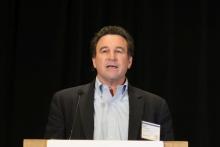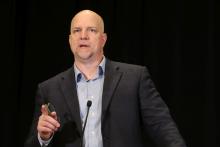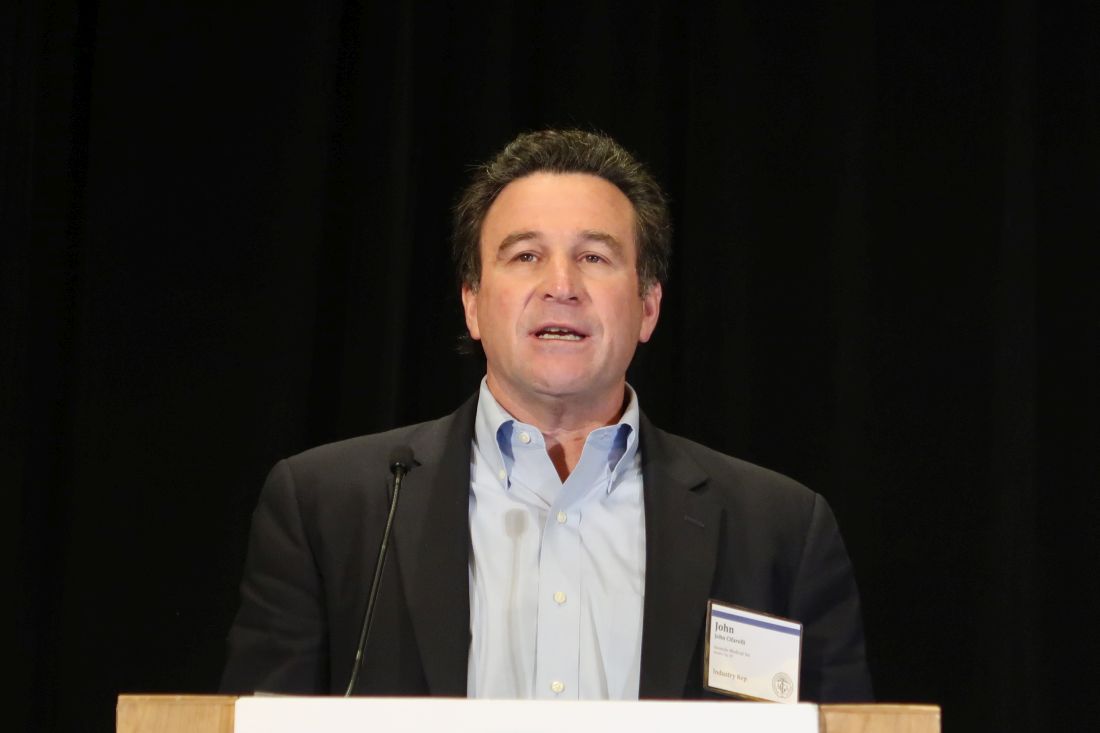User login
BOSTON – Two gastroenterology innovators spoke at the 2017 AGA Tech Summit, which is sponsored by the AGA Center for Innovation and Technology, to share how their past participation in the AGA Shark Tank panel is helping them succeed.
Single-use endoscopes
For Invendo Medical GmbH Chief Commercial Officer John Cifarelli, who appeared before the panel during the 2015 Tech Summit, having Shark Tank experts suggest that he and his collaborators keep in mind physician practice habits when bringing their single-use endoscope technology to market was key to their ultimate product designs.
Another Shark Tank panel suggestion Mr. Cifarelli said he and his team included was the use of high definition (HD) optics to enhance diagnosis. “The panel told me that physicians have become accustomed to the clarity of HD technology and would have trouble accepting anything less.”
The timing of his appearance before the panel was perfect, since Mr. Cifarelli and his team were still at the conceptual stage with the device. “We had just gone from a company that was making an inverted sleeve colonoscope to be used without sedation, to a company that provides full-platform HD conventional GI endoscopes that are sterile and single use, so we were able to incorporate the panel’s advice into our designs,” he said.
Rather than create a separate, stand-alone, hand-held device as planned, Invendo instead is manufacturing the InvendoscopeTM, a hand-held, HD optics, sterile, single-use device that can be used either attached to or detached from the endoscope – the first such device of its kind, he said. The Invendoscope recently received its CE mark and is expected to come to market later this year.
Mr. Cifarelli said his company is also at work on an HD, single-use, sterile gastroscope and duodenoscope, both of which he expects will be introduced by early 2018.
Technology IDs progression risk in Barrett’s
Appearing before the 2015 panel gave Cernostics CEO Mike Hoerres a comprehensive perspective that subsequently has served his collaborators and him well. The company was just issued two patents on the TissueCypherTM Image Analysis Platform, a tissue systems biology approach that evaluates protein expression in the context of tissue structure when analyzing biopsies from patients with Barrett’s esophagus. The assay technology simultaneously and objectively extracts high-dimensional biomarker expression and morphology data to evaluate multiple tumor, immune, and other stromal processes in a single tissue section.
Since then, quite a lot has happened for Cernostics and TissueCypherTM, including publication of two validation studies in 2016 demonstrating TissueCypherTM’s ability to predict progression to high-grade dysplasia or cancer, which are otherwise missed by standard histology. The company also received a $1.2 million grant from the National Institutes of Health for a phase II SBIR study that is being conducted with the Cleveland Clinic and the University of Pittsburgh Medical Center.
“We have shown that TissueCypherTM can identify who is 10 times more likely to progress to esophageal cancer within 5 years of biopsy vs. low-risk patients – something that is currently difficult to determine by standard pathology. This test could enable early intervention to prevent cancer in high-risk patients, and may spare low-risk patients frequent and unnecessary endoscopies and treatments,” Mr. Hoerres said in the interview.
Currently, about 3-4 million people in the U.S. are part of active surveillance programs for Barrett’s esophagus. “If the promise of the technology to decrease the utilization of endoscopy in patients who are unlikely to progress to dysplastic Barrett’s is realized, there will likely be significant savings in the care of these patients,” Dr. Michael L. Kochman, executive committee chair of the AGA Center for GI Innovation and Technology, said in an interview.
[email protected]
On Twitter @whitneymcknight
BOSTON – Two gastroenterology innovators spoke at the 2017 AGA Tech Summit, which is sponsored by the AGA Center for Innovation and Technology, to share how their past participation in the AGA Shark Tank panel is helping them succeed.
Single-use endoscopes
For Invendo Medical GmbH Chief Commercial Officer John Cifarelli, who appeared before the panel during the 2015 Tech Summit, having Shark Tank experts suggest that he and his collaborators keep in mind physician practice habits when bringing their single-use endoscope technology to market was key to their ultimate product designs.
Another Shark Tank panel suggestion Mr. Cifarelli said he and his team included was the use of high definition (HD) optics to enhance diagnosis. “The panel told me that physicians have become accustomed to the clarity of HD technology and would have trouble accepting anything less.”
The timing of his appearance before the panel was perfect, since Mr. Cifarelli and his team were still at the conceptual stage with the device. “We had just gone from a company that was making an inverted sleeve colonoscope to be used without sedation, to a company that provides full-platform HD conventional GI endoscopes that are sterile and single use, so we were able to incorporate the panel’s advice into our designs,” he said.
Rather than create a separate, stand-alone, hand-held device as planned, Invendo instead is manufacturing the InvendoscopeTM, a hand-held, HD optics, sterile, single-use device that can be used either attached to or detached from the endoscope – the first such device of its kind, he said. The Invendoscope recently received its CE mark and is expected to come to market later this year.
Mr. Cifarelli said his company is also at work on an HD, single-use, sterile gastroscope and duodenoscope, both of which he expects will be introduced by early 2018.
Technology IDs progression risk in Barrett’s
Appearing before the 2015 panel gave Cernostics CEO Mike Hoerres a comprehensive perspective that subsequently has served his collaborators and him well. The company was just issued two patents on the TissueCypherTM Image Analysis Platform, a tissue systems biology approach that evaluates protein expression in the context of tissue structure when analyzing biopsies from patients with Barrett’s esophagus. The assay technology simultaneously and objectively extracts high-dimensional biomarker expression and morphology data to evaluate multiple tumor, immune, and other stromal processes in a single tissue section.
Since then, quite a lot has happened for Cernostics and TissueCypherTM, including publication of two validation studies in 2016 demonstrating TissueCypherTM’s ability to predict progression to high-grade dysplasia or cancer, which are otherwise missed by standard histology. The company also received a $1.2 million grant from the National Institutes of Health for a phase II SBIR study that is being conducted with the Cleveland Clinic and the University of Pittsburgh Medical Center.
“We have shown that TissueCypherTM can identify who is 10 times more likely to progress to esophageal cancer within 5 years of biopsy vs. low-risk patients – something that is currently difficult to determine by standard pathology. This test could enable early intervention to prevent cancer in high-risk patients, and may spare low-risk patients frequent and unnecessary endoscopies and treatments,” Mr. Hoerres said in the interview.
Currently, about 3-4 million people in the U.S. are part of active surveillance programs for Barrett’s esophagus. “If the promise of the technology to decrease the utilization of endoscopy in patients who are unlikely to progress to dysplastic Barrett’s is realized, there will likely be significant savings in the care of these patients,” Dr. Michael L. Kochman, executive committee chair of the AGA Center for GI Innovation and Technology, said in an interview.
[email protected]
On Twitter @whitneymcknight
BOSTON – Two gastroenterology innovators spoke at the 2017 AGA Tech Summit, which is sponsored by the AGA Center for Innovation and Technology, to share how their past participation in the AGA Shark Tank panel is helping them succeed.
Single-use endoscopes
For Invendo Medical GmbH Chief Commercial Officer John Cifarelli, who appeared before the panel during the 2015 Tech Summit, having Shark Tank experts suggest that he and his collaborators keep in mind physician practice habits when bringing their single-use endoscope technology to market was key to their ultimate product designs.
Another Shark Tank panel suggestion Mr. Cifarelli said he and his team included was the use of high definition (HD) optics to enhance diagnosis. “The panel told me that physicians have become accustomed to the clarity of HD technology and would have trouble accepting anything less.”
The timing of his appearance before the panel was perfect, since Mr. Cifarelli and his team were still at the conceptual stage with the device. “We had just gone from a company that was making an inverted sleeve colonoscope to be used without sedation, to a company that provides full-platform HD conventional GI endoscopes that are sterile and single use, so we were able to incorporate the panel’s advice into our designs,” he said.
Rather than create a separate, stand-alone, hand-held device as planned, Invendo instead is manufacturing the InvendoscopeTM, a hand-held, HD optics, sterile, single-use device that can be used either attached to or detached from the endoscope – the first such device of its kind, he said. The Invendoscope recently received its CE mark and is expected to come to market later this year.
Mr. Cifarelli said his company is also at work on an HD, single-use, sterile gastroscope and duodenoscope, both of which he expects will be introduced by early 2018.
Technology IDs progression risk in Barrett’s
Appearing before the 2015 panel gave Cernostics CEO Mike Hoerres a comprehensive perspective that subsequently has served his collaborators and him well. The company was just issued two patents on the TissueCypherTM Image Analysis Platform, a tissue systems biology approach that evaluates protein expression in the context of tissue structure when analyzing biopsies from patients with Barrett’s esophagus. The assay technology simultaneously and objectively extracts high-dimensional biomarker expression and morphology data to evaluate multiple tumor, immune, and other stromal processes in a single tissue section.
Since then, quite a lot has happened for Cernostics and TissueCypherTM, including publication of two validation studies in 2016 demonstrating TissueCypherTM’s ability to predict progression to high-grade dysplasia or cancer, which are otherwise missed by standard histology. The company also received a $1.2 million grant from the National Institutes of Health for a phase II SBIR study that is being conducted with the Cleveland Clinic and the University of Pittsburgh Medical Center.
“We have shown that TissueCypherTM can identify who is 10 times more likely to progress to esophageal cancer within 5 years of biopsy vs. low-risk patients – something that is currently difficult to determine by standard pathology. This test could enable early intervention to prevent cancer in high-risk patients, and may spare low-risk patients frequent and unnecessary endoscopies and treatments,” Mr. Hoerres said in the interview.
Currently, about 3-4 million people in the U.S. are part of active surveillance programs for Barrett’s esophagus. “If the promise of the technology to decrease the utilization of endoscopy in patients who are unlikely to progress to dysplastic Barrett’s is realized, there will likely be significant savings in the care of these patients,” Dr. Michael L. Kochman, executive committee chair of the AGA Center for GI Innovation and Technology, said in an interview.
[email protected]
On Twitter @whitneymcknight
FROM THE 2017 AGA TECH SUMMIT


